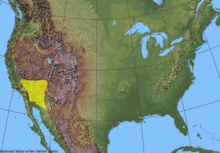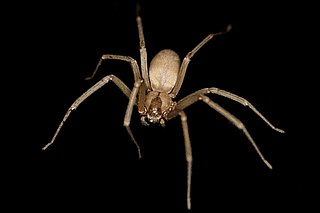
The brown recluse, Sicariidae is a recluse spider with necrotic venom. Similar to those of other recluse spiders, their bites sometimes require medical attention. The brown recluse is one of three spiders in North America with dangerous venom, the others being the black widow and the Chilean recluse.

The recluse spiders, also known as brown spiders, fiddle-backs, violin spiders, and reapers, is a genus of spiders that was first described by R. T. Lowe in 1832. They are venomous spiders known for their bite, which sometimes produces a characteristic set of symptoms known as loxoscelism.
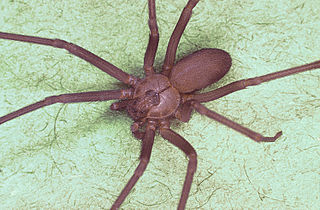
Sicariidae is a family of six-eyed venomous spiders known for their potentially necrotic bites. The family consists of three genera and about 160 species. Well known spiders in this family include the brown recluse spider and the six-eyed sand spider.

The Mediterranean recluse spider is a species of spider that originated in the Mediterranean region as its name implies, but can now be found in many parts of the world and is listed as one of the most invasive spiders worldwide. Usually dwelling in caves, the spiders will also inhabit basements and tunnels. Their webs shelter their egg sacs, which hatch into young that molt as they grow. The spider hunts at night and eats species including silverfish and cockroaches, and they usually target smaller insects.
Zebra is the American medical slang for a surprising, often exotic, medical diagnosis, especially when a more commonplace explanation is more likely. It is shorthand for the aphorism coined in the late 1940s by Theodore Woodward, professor at the University of Maryland School of Medicine, who instructed his medical interns: "When you hear hoofbeats behind you, don't expect to see a zebra." By 1960, the aphorism was widely known in medical circles. The saying is a warning against the statistical base rate fallacy where the likelihood of something like a disease among the population is not taken into consideration for an individual.

A spider bite, also known as arachnidism, is an injury resulting from the bite of a spider. The effects of most bites are not serious. Most bites result in mild symptoms around the area of the bite. Rarely they may produce a necrotic skin wound or severe pain.
Sphingomyelin phosphodiesterase D (EC 3.1.4.41, sphingomyelinase D) is an enzyme of the sphingomyelin phosphodiesterase family with systematic name sphingomyelin ceramide-phosphohydrolase. These enzymes catalyse the hydrolysis of sphingomyelin, resulting in the formation of ceramide 1-phosphate and choline:
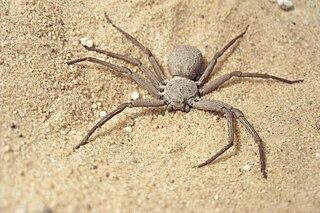
Sicarius is a genus of recluse spiders that is potentially medically significant to humans. It is one of three genera in its family, all venomous spiders known for a bite that can induce loxoscelism. They live in deserts and arid regions of the Neotropics, and females use a mixture of sand and silk when producing egg sacs. The name is Latin for assassin.

The Chilean recluse spider, Loxosceles laeta, is a highly venomous spider of the family Sicariidae. In Spanish, it is known as araña de rincón, or "corner spider"; in Brazilian Portuguese, as aranha-marrom or "brown spider". It is considered by many to be the most dangerous of recluse spiders, and its bites often result in serious systemic reactions, up to and including death.
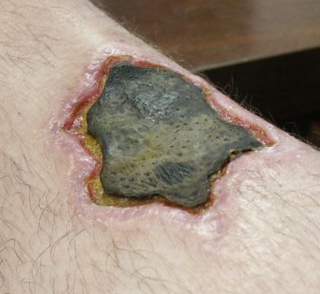
Loxoscelism is a condition occasionally produced by the bite of the recluse spiders. The area becomes dusky and a shallow open sore forms as the skin around the bite dies (necrosis). It is the only proven type of necrotic arachnidism in humans. While there is no known therapy effective for loxoscelism, there has been research on antibiotics, surgical timing, hyperbaric oxygen, potential antivenoms and vaccines. Because of the number of diseases that may mimic loxoscelism, it is frequently misdiagnosed by physicians.
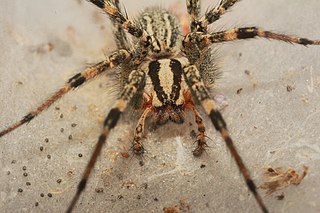
Agelenopsis aperta, also known as the desert grass spider or funnel-web spider, is a species of spider belonging to the family Agelenidae and the genus Agelenopsis. It is found in dry and arid regions across the southern United States and into northwestern Mexico. Their body is about 13–18 mm long and they have relatively long legs in order to run after their prey. Desert grass spiders can withstand very low temperatures even though they do not cold harden. It constructs the characteristic funnel-shaped webs in crevices where the funnel will fit, where they wait in the tube for prey which they can run after using their long legs. They often hunt for their prey at night.

Scytodes globula, the Chilean tiger spider, is a predatory spider of the family Scytodidae. In Spanish, it is known as araña tigre, or "tiger spider", but is also well known as "long-legged spider" or "spitting spider". It has achieved fame by being the only natural predator of the extremely common and dangerous Chilean recluse spider.
The pathophysiology of a spider bite is due to the effect of its venom. A spider envenomation occurs whenever a spider injects venom into the skin. Not all spider bites inject venom – a dry bite, and the amount of venom injected can vary based on the type of spider and the circumstances of the encounter. The mechanical injury from a spider bite is not a serious concern for humans. Some spider bites do leave a large enough wound that infection may be a concern. However, it is generally the toxicity of spider venom that poses the most risk to human beings; several spiders are known to have venom that can cause injury to humans in the amounts that a spider will typically inject when biting.
Chanbria is a genus of camel spiders. It consists of four species found in the Sonoran Desert in Mexico and the southwestern United States.

Hexophthalma is a genus of spiders in the family Sicariidae. Although the genus was originally erected in 1878, it was merged into the genus Sicarius in the 1890s, and remained unused until revived in 2017, when it was discovered that the African species then placed in Sicarius were distinct. The English name six-eyed sand spiders is used for members of the genus, particularly Hexophthalma hahni.

Sicarius thomisoides is a species of spider in the family Sicariidae, found in Chile. It is the type species of the genus Sicarius. Its correct name has been the source of confusion. It has often been known by the synonym Sicarius terrosus, a name which has also often been used incorrectly for other species.

Loxosceles intermedia, the Brazilian brown recluse spider, is a highly venomous spider species in the family Sicariidae native to Brazil and Argentina.

Loxosceles gaucho commonly known in English as the gaucho spider. is a highly venomous recluse spider endemic to South America.
Loxosceles sonora is a species of venomous recluse spider in the family Sicariidae. It is an relative of the species L. deserta via allopatric speciation. The etymology of the species name is the Mexican state of Sonora. They are also found in the neighboring state of Sinaloa.

